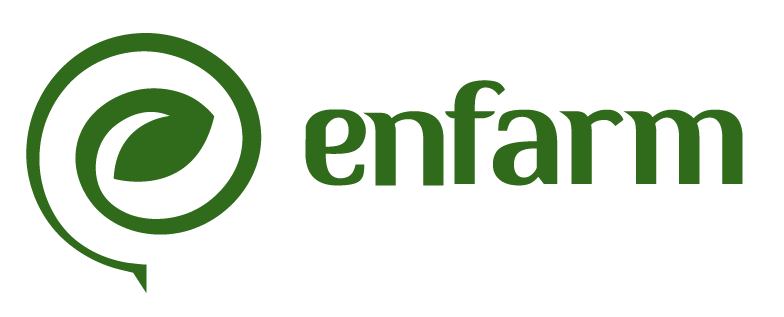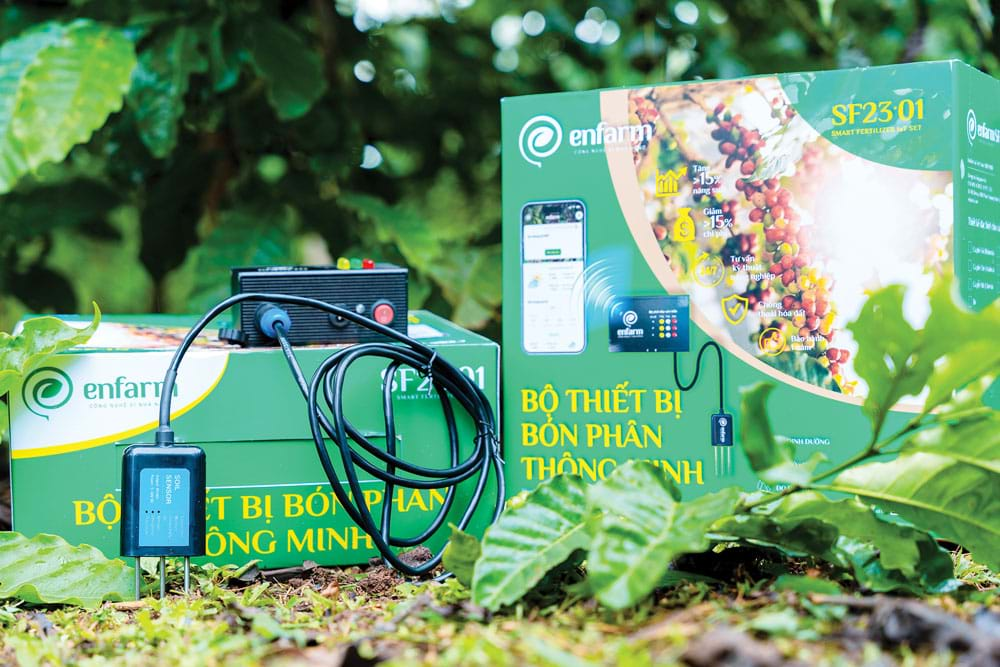News
“Smart Fertilization” – A Path Toward Sustainable Agriculture
Enfarm Agritech applies the Internet of Things (IoT) and Artificial Intelligence (AI) to develop smart fertilization technology with the goal of increasing farmers’ income, protecting the environment, and creating a sustainable agricultural ecosystem. After completing its laboratory research phase, the startup with headquarters in Singapore and Ho Chi Minh City is now moving into field trials in the Central Highlands of Vietnam.
A study published on the official portal of the Ministry of Agriculture and Rural Development shows that fertilizer in Vietnam is not being used efficiently or sustainably. Fertilization efficiency stands at only 40 percent, meaning that around 60 percent of fertilizer is not absorbed by plants and remains in the environment. This equates to approximately 1.77 million tons of urea (N), 2.07 million tons of superphosphate (P), and 344 thousand tons of potassium (K). The estimated annual loss amounts to 60 trillion VND based on current fertilizer prices. This figure is higher than the total budget revenue of 57 provinces in 2022.

Mr. Long Phi Ho, Co-founder and Chief Technology Officer (left), and Mr. Do Dung Nguyen, Co-founder and Chief Executive Officer of Enfarm Agritech.
The inefficiency in fertilizer use not only affects farmers’ incomes but also causes significant environmental pollution. Therefore, solving the fertilizer problem is equivalent to removing a major obstacle to the sustainable development of Vietnamese agriculture. This is the reason why the founders of Enfarm Agritech chose to focus their research on smart fertilization solutions, starting with high-input crops such as coffee and durian.

Livelihood transformation
According to the General Statistics Office, Vietnam’s coffee export turnover surpassed 4 billion USD for the first time in 2022, marking a 32 percent increase in value and a 13.8 percent rise in volume compared to the 2021 crop year. Although Vietnam leads the world in robusta production, accounting for 40 percent of global output, its farmers remain disadvantaged as prices are dictated by the London exchange.
A study by Fulbright University shows that farmers receive only 2 percent of the retail value of a cup of coffee sold in Western countries, which are the destination for 60 percent of Vietnam’s coffee exports. Farmers continue to be the least benefited yet most vulnerable actors in the value chain. Is there still room to improve incomes for smallholder coffee farmers?

Leaders of the Western Highlands Agroforestry Scientific and Technical Institute and Enfarm Agritech sign a research collaboration agreement on smart fertilization technology.
Changing fertilizer usage habits and building strong branding for Vietnamese agricultural products is one approach.
“Enfarm’s smart fertilization technology can help increase farmers’ income by 1.5 times for coffee cultivation. But for farmers to adopt technology, it must be affordable and easy to use,” said Do Dung Nguyen, Co-founder and CEO of Enfarm Agritech. The company’s first product is a handheld multifunctional measuring device, the SF23-01, which can measure NPK levels, moisture, and pH at only one-fifth the cost of the cheapest devices currently on the market.
The key to lowering costs lies in centralized data processing and using smartphones to deliver recommendations through the Enfarm app, rather than designing each handheld unit as a mini-computer with a processor and display screen. The device consists of two main components. The first is a sensor inserted 30 cm into the soil to collect information related to crop growth and soil nutrients. The second is a data logger that transmits the information to a central server located in Ho Chi Minh City every 15 minutes for analysis, and then returns recommendations to farmers via the Enfarm app. By identifying the levels of plant-available nutrients in real time, the SF23-01 can advise each farm owner on when to fertilize, what type to use, and in what amount.
Experimental results from the Western Highlands Agroforestry Scientific and Technical Institute show that for coffee plants, using the correct fertilization formula can increase yields by up to 20 percent while reducing fertilizer costs by 20 percent. At current coffee prices of 65 million VND per ton of green beans and an average yield of 3.5 tons per hectare, a 20 percent increase in productivity equals an additional 45 million VND per year. Meanwhile, smart fertilization can help each household save around 6 million VND per hectare in fertilizer expenses. This translates to an increase in income by 1.5 to 2 times for farmers.
Diagnosing the right problem, prescribing the right solution
Before co-founding Enfarm Agritech, Mr. Long Phi Ho was known as an expert in water resources and climate change. According to him, solving the fertilizer problem also contributes to reducing greenhouse gas emissions. The production of nitrogen fertilizer, one of the three most essential nutrients for plants, consumes a significant amount of energy. The portion of nitrogen fertilizer that is not absorbed by crops is released into the atmosphere as nitrous oxide, a gas that increases global temperatures much faster than carbon dioxide. Scientists at the University of Cambridge in the United Kingdom estimate that fertilizer accounts for 5 percent of total global greenhouse gas emissions.
Mr. Ho explained that improper fertilization creates a vicious cycle. Excess fertilizer leads to soil acidification. When soil pH drops below 5, plants reduce their uptake of nutrients. Soluble nitrogen absorption decreases by 40 percent, phosphorus by about 70 percent, and potassium by 20 percent. Acidic soil forces farmers to apply more fertilizer, which increases costs and further worsens soil conditions. This cycle of over-fertilization and soil degradation reduces farmers’ income and causes environmental damage. Excess fertilizer is washed away by surface water during rainfall or leaches into groundwater, contaminating water sources.
To break this cycle, Enfarm’s technology offers a comprehensive solution using artificial intelligence. After analyzing data, including soil nutrients, soil properties, and weather trends, the system provides concise recommendations sent directly to the farmer’s smartphone. Enfarm’s sensors, which are continuously embedded in the soil, can generate specific guidance for each crop based on its growth stage, weather patterns, and local soil conditions.
Mr. Ho explained that plant growth is visualized through easy-to-read charts. For example, if fertilizer is applied and the chart rises steeply, it indicates strong nutrient uptake by the roots. A flat chart shows that the roots are not absorbing nutrients effectively, and applying more fertilizer at that point would be counterproductive.
Towards fair trade
After more than a year of promising results from experimental trials using smart fertilization technology on 500 coffee samples grown in planting tubes in Ho Chi Minh City, Enfarm Agritech is now ready to move into the fields. A specialty clean coffee company and a local cooperative have agreed to deploy the SF23-01 device across nearly 1,000 hectares of coffee-growing land in Dak Lak. If the results prove effective, Enfarm will have the opportunity to reach the cooperative’s members and gain recognition within the coffee farming community. Additionally, the GPS functionality integrated into Enfarm’s device offers a solution to a pressing issue: verifying that agricultural land does not originate from deforestation. This meets a key requirement from the European Union, one of Vietnam’s most important agricultural export markets.
“To create meaningful social and environmental impact, we must reach every farming household and ensure market access for their produce,” said Do Dung Nguyen. For that reason, alongside ongoing technology improvement, cost reduction, and the development of shared economic models, Enfarm Agritech is also seeking collaboration with agricultural procurement and export companies. Produce grown with support from Enfarm’s technology will be both economically viable and environmentally friendly, with the potential to elevate its branding in international markets and command higher prices.
“Our goal is fair trade. Enfarm’s technology not only empowers farmers to become agricultural experts who understand both the weather and their land, but also equips them with insights into price trends and market access. More importantly, with technology, farmers can connect with traders, businesses, and even end consumers. That is the mission we pursue,” Mr. Nguyen shared, outlining Enfarm Agritech’s vision.
In September, the Central Highlands begins its coffee harvest season. Will Enfarm Agritech help farmers make a breakthrough? Time will tell.


